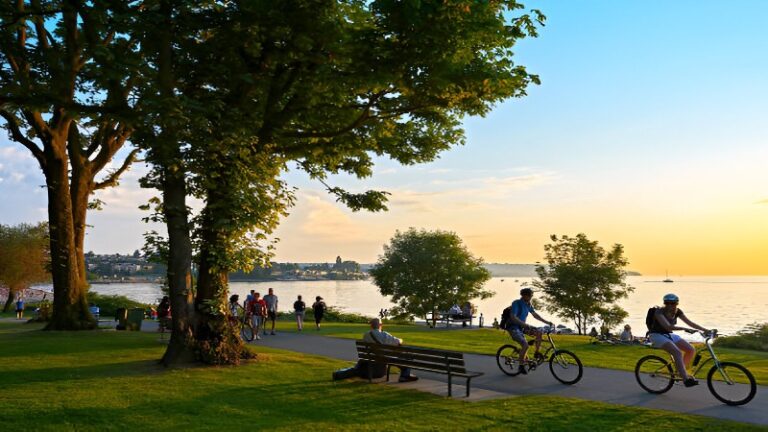As city populations continue to swell globally, the concrete jungles we inhabit often feel increasingly disconnected from nature. Yet, the longing for a breath of fresh air, a patch of green, and a moment of tranquility amidst urban chaos remains universal. Creating green spaces in city living isn’t just an aesthetic luxury; it’s a fundamental necessity for enhancing quality of life, fostering well-being, and building truly sustainable urban environments.
The Undeniable Benefits of Green Spaces in Urban Environments
The positive impact of urban green spaces extends far beyond their visual appeal. They act as vital organs of a city, performing critical functions that improve environmental health and human well-being.
Environmental Regulators:
-
- Improved Air Quality: Plants act as natural air filters, absorbing pollutants like carbon dioxide and releasing oxygen. This directly combats the toxic air prevalent in many urban areas, which contributes to millions of deaths annually.
- Mitigation of Urban Heat Islands (UHIs): Concrete and asphalt absorb and retain heat, making cities significantly hotter than surrounding rural areas. Green spaces, through shade and evapotranspiration (plants releasing water vapor), can reduce local temperatures by up to 2°C, decreasing the demand for energy-intensive cooling. Research published in the Journal of Environmental Management supports this cooling effect.
- Enhanced Stormwater Management: Green roofs, rain gardens, and permeable green spaces absorb rainwater, reducing runoff and alleviating strain on city drainage systems, preventing urban flooding.
Health and Well-being Boosters:
-
- Promote Physical Activity: Accessible parks and walking trails encourage residents to engage in physical activities like walking, cycling, and sports, which are crucial for combating sedentary lifestyles. A study in the Journal of Science and Medicine in Sport linked proximity to green spaces with higher physical activity levels.
- Mental Restoration: Even short exposures to nature (5-10 minutes) can significantly reduce stress levels, improve mood, and boost cognitive function and concentration, counteracting the mental fatigue of city life.
- Social Connection: Green spaces serve as communal hubs, encouraging social interaction, community building, and a sense of belonging among diverse residents.
Biodiversity Sanctuaries:
-
- Habitat Creation: Urban green areas, especially those incorporating native plant species, provide essential habitats for various plant, insect, and bird species, supporting urban biodiversity. The Journal of Ecology highlights how urban parks can host a significant portion of a city’s biodiversity.
- Ecosystem Services: Thriving urban ecosystems, even small ones, contribute to a healthier environment by supporting pollinators, natural pest control, and soil health, reducing the need for artificial interventions.
Innovative Approaches to Creating Green Spaces
Creating green spaces in city living demands creativity and smart design, especially with limited land. The focus is shifting from simply having parks to integrating greenery at every possible scale.
| Type of Green Space | Description | Key Benefits in Urban Settings |
| Vertical Gardens (Living Walls) | Plants grown vertically on building facades. | Aesthetic appeal, air purification, building insulation, limited footprint. |
| Green Roofs | Vegetation installed on building rooftops. | Stormwater retention, insulation (reduces energy costs), UHI mitigation, new public/private spaces. |
| Pocket Parks / Micro-Parks | Small, often overlooked urban plots transformed into miniature green areas. | Accessibility in dense areas, quick wins, community engagement opportunities. |
| Podiums & Terraces | Elevated platforms and outdoor spaces on multi-story buildings, integrated with greenery. | Maximizes usable green space, provides private/semi-private retreats. |
| Street Trees & Bioswales | Trees planted along streets and vegetated channels designed to manage stormwater runoff. | Shade, air filtration, water management, aesthetic improvement, habitat corridors. |
| Community Gardens | Shared garden plots managed by local residents. | Food production, social cohesion, educational opportunities, physical activity. |
The Imperative of Equitable Access
While the benefits of creating green spaces in city living are clear, a fresh perspective highlights a critical challenge: ensuring these benefits are accessible to everyone. The phenomenon of “green gentrification” often sees new green spaces driving up property values, inadvertently displacing the very communities who need them most.
To truly foster an urban oasis, cities must prioritize:
- Democratizing Green Space: Green areas must be easily accessible and genuinely public, free from pressure to spend money, and welcoming to all socioeconomic groups. They should be designed to foster interaction among diverse residents.
- Inclusive Design: Design must consider all users, incorporating features like wheelchair-accessible pathways, sensory gardens, and culturally relevant planting.
- Community-Led Initiatives: Involving local communities in the planning, design, and maintenance of green spaces ensures that these areas meet their specific needs and reflect their identities, fostering ownership and sustainability.
- Policy & Incentives: Governments and urban planners must implement policies that prevent displacement while incentivizing developers to integrate green infrastructure into affordable housing projects. This can include flexible zoning, density bonuses for green design, and public-private partnerships focused on equitable development.
Key Considerations
Effective design is paramount to maximize the impact of your urban oasis.
- Accessibility and Inclusivity: Ensure pathways, seating, and facilities are usable by people of all ages and abilities.
- Native Plant Species: Prioritize plants indigenous to the local ecosystem. They require less water and maintenance, support local biodiversity more effectively, and are more resilient to regional climate conditions.
- Sustainable Practices: Implement rainwater harvesting, efficient irrigation, and use permeable surfaces to manage water resources wisely.
- Balance with Urban Development: Integrate green spaces into urban planning from the outset, rather than as an afterthought. This means considering them alongside housing, infrastructure, and transportation needs.
Your Role in Growing an Urban Oasis
Whether you’re an urban planner, a developer, or a city resident, you have a part to play in creating green spaces in city living.
- For Individuals: Support local parks, participate in community gardening, advocate for green policies, and embrace balcony or indoor gardening. Even a small wildflower meadow in a pot contributes.
- For Planners & Policy Makers: Prioritize equitable access, foster community engagement, and implement progressive policies that incentivize sustainable green infrastructure development.
- For Developers: Seek opportunities to integrate vertical gardens, green roofs, and communal green spaces into projects, understanding their long-term value for both residents and the environment.
Conclusion
The future of our cities hinges on our ability to reintegrate nature. By consciously creating green spaces in city living that are not only ecologically robust but also socially just, we can cultivate vibrant, healthy, and resilient urban environments for generations to come. The goal is to move beyond mere patches of green to truly weave nature into the fabric of urban life, making every city a place where all can thrive.
Frequently Asked Questions (FAQs)
What are urban green spaces?
Urban green spaces are any vegetated areas within a city, ranging from large parks and community gardens to green roofs, vertical gardens, and street trees.
How do green spaces improve city air quality?
Green spaces improve air quality by having plants absorb pollutants and release oxygen, acting as natural filters to clean the urban air.
Can green spaces help cool down cities?
Yes, green spaces help mitigate the urban heat island effect by providing shade and cooling the surrounding air through evapotranspiration, reducing city temperatures.
Why is equitable access to urban green spaces important?
Equitable access ensures that all city residents, regardless of income or neighborhood, can enjoy the health and social benefits of green spaces, preventing disparities and fostering inclusive communities.
What are some innovative ways to create green spaces in dense urban areas?
Innovative ways include developing vertical gardens, green roofs, transforming small lots into pocket parks, and integrating greenery into podiums and terraces on buildings.


